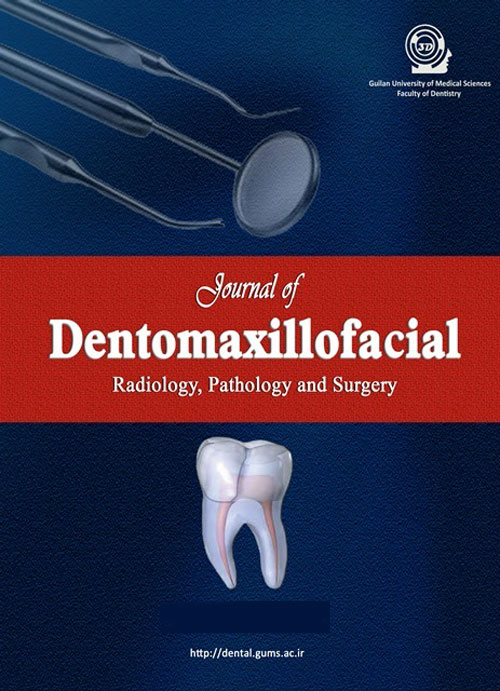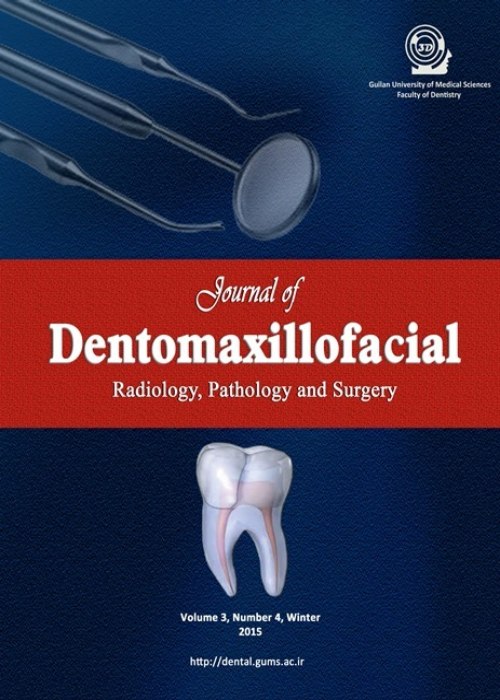فهرست مطالب

Journal of Dentomaxillofacil Radiology, Pathology and Surgery
Volume:4 Issue: 4, Winter 2016
- تاریخ انتشار: 1395/01/26
- تعداد عناوین: 6
-
-
Pages 1-6Introdouction: An exact knowledge of the anatomical variations of the paranasal sinuses (PNS) is critical for surgeons performing endoscopic sinus surgery and for radiologists involved in making preoperative evaluations. An important aspect is the determination of correlation between the anatomical variations of PNS and the presence of chronic rhinosinusitis (CR). Cone-beam computed tomography (CBCT) has a very important role in evaluating the maxillofacial structures. The purpose of this pilot study was to evaluate the anatomical variations of PNS in patients with CR as compared with normal individuals.Materials And MethodsThis cross-sectional study evaluated the CBCT scans of 57 patients with CR and 28 patients without CR. Anatomical variations observed in the multiplanar images were investigated. Data were processed using SPSS software. Fishers exact test was used for comparing the incidence of different anatomical variations in the control (normal) and CR (experimental) groupsResultsThe most frequent anatomical variation was septal deviation in 85.7% of normal individuals and 93% of patients with CR. No statistically significant difference existed between the prevalence of anatomical variations in both groups. In contrast, middle concha bullosa was more prevalent in normal individuals than in patients with CR.ConclusionAnatomical variations occurring in the PNS alone can not lead to CR. It may be accompanied by systemic, local, and environmental factors that could increase the susceptibility of the patient to this disease.Keywords: Sinusitis, Paranasal Sinuses, Cone, Bea, Computed Tomography
-
Pages 7-15IntroductionCancer is the second cause of death in the world and the third primary cause in Iran. In this study, we examined the epidemiology of oral squamous cell carcinoma (OSCC) as the most common malignancy of the oral cavity and its related factors in Yazd Province, Iran, from 2001 to 2011.Materials And MethodsThis descriptive study evaluated the medical records of patients with OSCC in the chief hospital in the city of Yazd. Data were extracted based on the demographic and primary etiologic, clinical, and pathological characteristics. Data were analyzed with t-test and chi-square test at a significance level of αResultsOSCC consisted of 54% of the malignancies of the head and neck region, which are most common in the sixth decade of life with a male-tofemale ratio of 1.4:1. The average patients age was 62.81 years. The average annual incidence of OSCC in Yazd indigenous population during the study period was 1.02 out of 100,000 individuals. Overall, 49.3% of patients used tobacco or snuff, and the number of females exposed to these factors was significantly less than that of males (P =0.001). The most common microscopic diagnosis was squamous cell carcinoma (SCC) (76%), followed by verrucous carcinoma (21.1%); 55.8% of patients had well-differentiated SCC, and 42.6% exhibited moderately differentiated SCC. The tongue was the most common site of involvement (41.1%), and the most common clinical feature was exophytic lesions (51.4%).ConclusionThe general epidemiological pattern of OSCC in this study was similar to other studies. In older patients (seventh and eighth decades) and females (particularly in cases of tongue), etiologic factors other than tobacco may play more prominent roles.Keywords: Carcinoma, Squamous Cell, Mouth Neoplasms, Prevalence
-
Pages 16-19Introdouction: Canal length measurement is essential for proper endodontic treatment. Any error or miscalculation in working length determination, particularly in curved canals, can result in complications during or after root canal therapy. Digital radiography has enabled accurate measurement of curved canal length. In this study, we evaluated the accuracy of calibration of a complementary metal oxide semiconductor (CMOS) digital system for file length measurement.Materials And MethodsIn this in vitro study, 45extracted molar teeth were divided into three groups of 15 with respect to the angle and radius of canal curvature. A 5-mm piece of orthodontic wire was placed on the lateral surface of the roots. Digital radiographs were taken after insertion of the endodontic file by the CMOS digital system. Two observers measured the file length with and without using the calibration tool of digital measurement software. The correlation between observers was evaluated and data were analyzed using the paired t-test with 95% confidence interval.ResultsThe overall agreement between the observers was satisfactory. There was no significant difference between the mean values of calibrated measurement and true file length with respect to canal curvature (P>0.05). However, there was a significant difference between the mean values of uncalibrated measurement and true file length with respect to canal curvature (PConclusionThe calibrated measurement of file length was more accurate than the uncalibrated file length measurement.Keywords: Digital Dental Radiography, Root Canal Therapy, Calibration
-
Pages 20-30Introdouction: This study investigated the potential relationship between vertical facial growth patterns and airway volumes in a sample of Iranian adult patients.Materials And MethodsThis cross sectional study was conducted on 72 adult patients (44 females, 28 males), ages 1845 years, who had been referred to the Department of Oral and Maxillofacial Radiology at the Shiraz University of Medical Science. The vertical growth pattern was assessed by a lateral cephalometric radiograph using two indices: morphological facial index (defined as the ratio of N-Mn and Zy-Zy distance) and Jarabak index (defined as the ratio of S-Go and N-Gn). The sizes of the superior and inferior airway compartments were measured by employing cone beam computed tomography. Data were analyzed on SPSS 21 using the ShapiroWilk test, p-p plot test, one-way ANOVA, t-test, and chi square tests (PResultsThe total airway volume for all individuals was 21.72 ± 6.69 mm. There were no statistically significant differences between subjects with long, medium, or short faces regarding lower (p = 0.160) or upper (p = 0.183) airway sizes. The gender of the participants did not have a significant relationship with the lower, upper, or total airway sizes.ConclusionBased on the findings of the current study, we found that the cone beam computed tomography data did not indicate any correlation between airway volume and vertical facial growth pattern.Keywords: Tidal Volume, Cone Beam Computed Tomography
-
Pages 31-35IntroductionVarious intraoral digital radiographic systems are available as an alternative to film-based radiography. Recent rapid progress in the field of digital radiography offers the possibility of image processing and manipulation. Pseudocolor filter is one of the tools of digital systems. The aim of this study was to compare diagnostic accuracy of proximal caries in black and white and colorized images.Materials And MethodsIn this in vitro study, forty extracted premolar were selected and mounted in acrylic blocks. The teeth were radiographed with complementary metal-oxide semiconductor (CMOS) digital sensor. Two observers evaluated the images with and without application of the pseudocolor tool. The teeth were sectioned for histological determination of the lesion. The diagnostic accuracy of each method was assessed by means of ROC analysis.ResultsThere were no significant differences between the black and white and colored mode of images (P = 0.973). There were no significant differences between observers.ConclusionColor mode of digital images can be used for proximal caries detection.Keywords: Dental Caries, Diagnosis, Digital Dental Radiography
-
Pages 36-38Gingiva is a common region of inflammatory and reactive lesions. Systemic conditions, including hormonal imbalance in pregnant women, may cause exaggerated response to irritations such as calculus or infection. Therefore, more accurate assessment is necessary to achieve the best decision making in the differential diagnosis and treatment of these patients. In this paper, we present a reactive hyperplastic lesion of endodontic origin (parulis) on the gingiva in a pregnant woman, which mimicking pregnancy tumor.Keywords: Gingival Hyperplasia, Pyogenic Granuloma, Pulpitis


